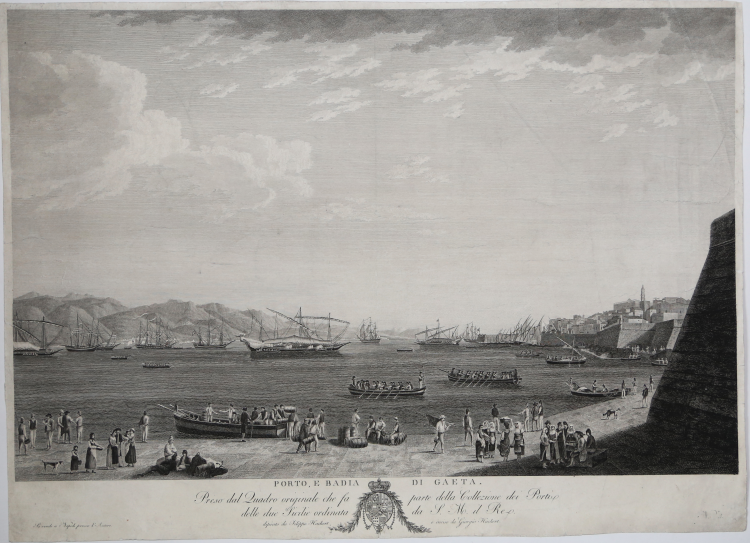



| Reference: | s29877 |
| Author | Georg Abraham HACKERT |
| Year: | 1790 ca. |
| Zone: | Gaeta |
| Printed: | Naples |
| Measures: | 727 x 529 mm |


| Reference: | s29877 |
| Author | Georg Abraham HACKERT |
| Year: | 1790 ca. |
| Zone: | Gaeta |
| Printed: | Naples |
| Measures: | 727 x 529 mm |
Beatiful view engraved and published by Georg Abraham Hackert, after the original painting by his brother Jacob Philipp Hackert, then serving as court painter to Ferdinand IV, king of both Naples and Sicily. Probably painted in 1789, depicts a scene of the daily life of the port at Gaeta is shown where all strata of society from barefoot peasant women and male watermen to upper class women in powdered wigs and a man in a frock coat converse in the shadow of a massive stone wall.
The caption states that the subject is based on painting from the “Collection of the Ports of the Two Sicilies” painted by Jacob Hackert for King Ferdinand IV. It is not known exactly how many paintings by Hackert were part of this so called “collection,” but one scholar, Sergio Attanasio, has summarized recent research on the subject, included the identification of the original painting that was the source for the this engraving. According to Attanasio, in 1799, members of the French army entered the studio of the engraver Georg Hackert at Palazzo Cellamare taking possession of the 17 views of the kingdom that his brother, Jacob Hackert, had painted between approximately 1788 and 1794.
Engraving, in good condition.
|
Attanasio, Sergio. 2007. Palazzo di Cittá -- Villa di Campagna: La committenza nobiliare nel Settecento a Napoli e nel Vesuviano. pp. 11-15. http://www.exallievi-villafavorita.net/villa/rep/estratto.pdf (4 January 2013).
|
Georg Abraham HACKERT (Prenzlau, 1755; Firenze, 1805)
|
Brother of Philipp Hackert. He trained in Berlin with F. G. Berger and went to Italy in 1776 at the invitation of his elder brother Philipp. Though his training was based mainly on 17th-century Dutch and Flemish art, he was soon influenced by the Neo-classical theories of Winckelmann and Mengs. His work in Rome compromises effectively between a calligraphic approach and the Romantic spirit. In fact, while faithfully rendering his brother’s landscapes, he managed to infuse a new sense of nature into his engravings. He had the ability to illustrate a scene as if engraving from life rather than from a painting. Georg did most of his work in Naples, where the Bourbon court appointed him official engraver. In this position he was an upholder and propagator of Neo-classical theories, but his influence on Neapolitan engraving, especially through his renderings of his brother’s great canvases of Ports of the Realm, remains to be studied. He fled Naples with his brother in 1799.
|
|
Attanasio, Sergio. 2007. Palazzo di Cittá -- Villa di Campagna: La committenza nobiliare nel Settecento a Napoli e nel Vesuviano. pp. 11-15. http://www.exallievi-villafavorita.net/villa/rep/estratto.pdf (4 January 2013).
|
Georg Abraham HACKERT (Prenzlau, 1755; Firenze, 1805)
|
Brother of Philipp Hackert. He trained in Berlin with F. G. Berger and went to Italy in 1776 at the invitation of his elder brother Philipp. Though his training was based mainly on 17th-century Dutch and Flemish art, he was soon influenced by the Neo-classical theories of Winckelmann and Mengs. His work in Rome compromises effectively between a calligraphic approach and the Romantic spirit. In fact, while faithfully rendering his brother’s landscapes, he managed to infuse a new sense of nature into his engravings. He had the ability to illustrate a scene as if engraving from life rather than from a painting. Georg did most of his work in Naples, where the Bourbon court appointed him official engraver. In this position he was an upholder and propagator of Neo-classical theories, but his influence on Neapolitan engraving, especially through his renderings of his brother’s great canvases of Ports of the Realm, remains to be studied. He fled Naples with his brother in 1799.
|